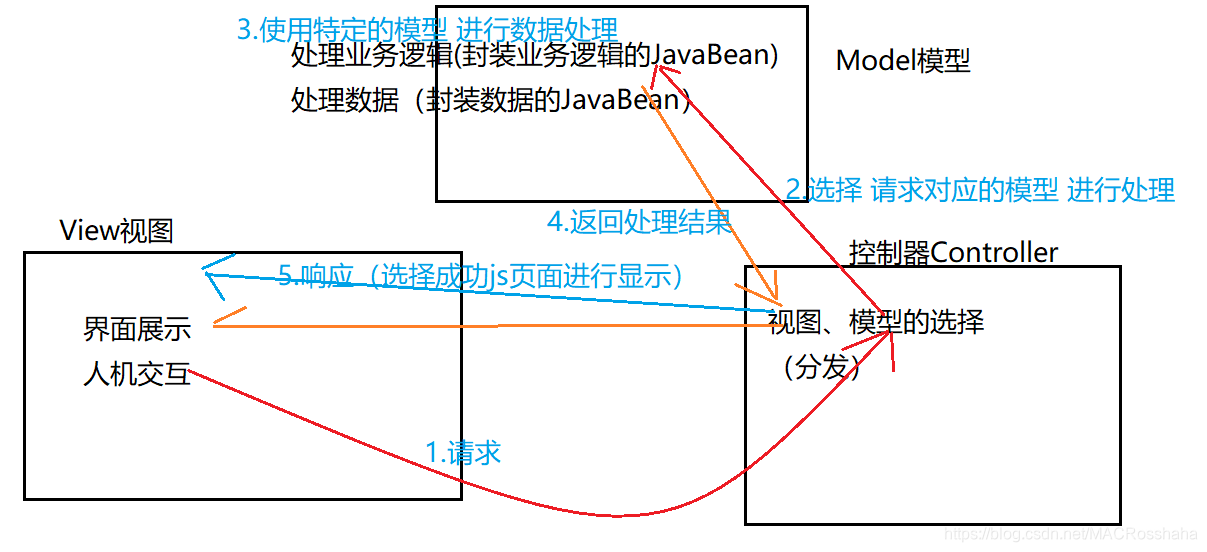MVC设计模式
M:Model ,模型 :一个功能。用JavaBean实现。
V:View,视图: 用于展示、以及与用户交互。使用html js css jsp jquery等前端技术实现
C:Controller,控制器 :接受请求,将请求跳转到模型进行处理;模型处理完毕后,再将处理的结果
返回给 请求处 。 可以用jsp实现, 但是一般建议使用 Servlet实现控制器。
Jsp->Java(Servlet)->JSP


三层架构
与MvC设计模式的目标一致:都是为了解耦合、提高代码复用
区别,二者对项目理解的角度不同。
三层组成
表示层(USL, User Show Layer;视图层)
前台:对应于MVC中的view,用于和用户交互、界面的显示
jsp js html css jquery等web前端技术
代码位置: WebContent
后台:对用于MvC中 Controller,用于控制跳转、调用业务逻辑层
Servlet( SpringMvc struts2),位于xxx. servlet包中
业务逻辑层(BLL, Business logic layer; Service层)
接收表示层的请求调用
组装数据访问层,逻辑性的操作(增删改査,删:査+删),
一般位于xxx. service包(也可以成为:xxx. manager,xx.b11)
数据访问层(DAL, Data Access layer;Dao层)
直接访问数据库的操作,原子性的操作(增删改查)
一般位于xxx.dao包
三层间的关系:
上层将请求传递给下层,下层处理后返回给上层

[外链图片转存失败,源站可能有防盗链机制,建议将图片保存下来直接上传(img-h0K6GNjg-1587476027780)(F:\用户\MACROSS\大学\资料\WEB开发技术\Jαva Web配套资料\9三层优化\三层.png)]
三层优化
1.加入接口
建议面向接口开发:先接口-再实现类
--service、dao加入接口
--接口与实现类的命名规范
接口:interface, 起名 I实体类Service IStudentService
IStudentDao
实现类:implements 起名 实体类ServiceImpl StudentServiceImpl
StudentDaoImpl
接口: I实体类层所在包名 IStudentService、IStudentDao
接口所在的包: xxx.service xx.dao
实现类: 实体类层所在包名Impl StudentServiceImpl、StudentDaoImpl
实现类所在的包:xxx.service.impl xx.dao.impl
以后使用接口/实现类时,推荐写法:
接口 x = new 实现类();
IStudentDao studentDao = new StudentDaoImpl();
2.DBUtil 通用的数据库帮助类,可以简化Dao层的代码量
帮助类 一般建议写在 xxx.util包
方法重构: 将多个方法 的共同代码 提炼出来,单独写在一个方法中,然后引入该方法即可
Apache DBUtils
下载commons-dbutils-1.7.jar,其中包含以下几个重点类:
DbUtils、QueryRunner、ResultSetHandler
DbUtils:辅助
QueryRunner:增删改查
update() 增删改 参考word文档
自动提交事务 update(sql,参数);update(sql);
手动提交事务 update(connection ,sql,参数);
手动提交事务
转账: zs -1000 -> ls +1000
query()查询
如果是查询,则需要ResultSetHandler接口,有很多实现类,一个实现类对应于一种 不同的查询结果类型
select * from student -> List
select count(1) from student ; int
– Object[] , {1,zs}
实现类ArrayHandler :返回结果集中的第一行数据,并用Object[]接收
Object[] = {1 ,zs,23};
实现类ArrayListHandler:返回结果集中的多行数据, List<Object[]>
–Student (1 ,zs)
BeanHandler :返回结果集中的第一行数据,用对象(Student)接收
BeanListHandler:返回结果集中的多行数据, List students, stu stu2 stu3
BeanMapHandler: 1:stu,2:stu2, 3:stu3
//反射会通过无参构造来创建对象
– Map
MapHandler:返回结果集中的第一行数据
{id=1 ,name=zs}
String,int
String,String
–>
String,Object
MapListHandler:返回结果集中的多行数据
{{id=2 ,name=ls},{id=3 ,name=ww}}
KeyedHanlder
{ls={id=2 ,name=ls},ww={id=3 ,name=ww}}
–>
ColumnListHander :把結果集中的某一列 保存到List中
2,ls
3,ww
{ls,ww}
–>
select count(1) from xxx ; 23
select name from student where id =2 ;
ScalarHandler :单值结果
问题:查询的实现类的参数问题
query(…, Object… params )
其中Object… params代表可变参数: 既可以写单值,也可以写一个数组
runner.query("… where id = ? and name like ? " ,new ArrayHandler(),new Object[]{1,"%s%"}) ;
runner.query("… where id = ?" ,new ArrayHandler(),1) ;
ORA-00904: “NAMEIKE”: 标识符无效 : SQL关键字写错, ojdbc.jar版本问题
,new Object[]{1,"%s%"}) ;
runner.query("… where id = ?" ,new ArrayHandler(),1) ;
ORA-00904: “NAMEIKE”: 标识符无效 : SQL关键字写错, ojdbc.jar版本问题
数据分页:5变量(属性)
1.数据总数
(select count(*) from xxx , 查数据库)
2.页面大小
(页面容量,每页显示的数据条数) (用户自定义)
3.总页数 (自动计算)
800:10= 80页
总页数= 数据总数 /页面大小
802:10= 800/10 +1 ;
总页数= 数据总数 /页面大小 + 1;
–>通式
总页数= 数据总数 % 页面大小==0 ?数据总数 /页面大小:数据总数 /页面大小 + 1;
注意:自动计算的时机:当 数据总数 和 页面大小都被赋值以后,自动计算总页数。
4.当前页码 (用户自定义)
5.实体类对象集合
(当前页的数据集合):依赖于数据库 (查数据库)
假设: 每页显示10条(页面大小=10)
MYSQL实现分页的sql:
limit开始,多少条
第0页
select * from student limit 0, 10
第1页
select * from student limit 10, 10
第2页
select * from student limit 20, 10
第n页
select * from student limit n 10, 10
select * from student limit 页数*页面大小,页面大小